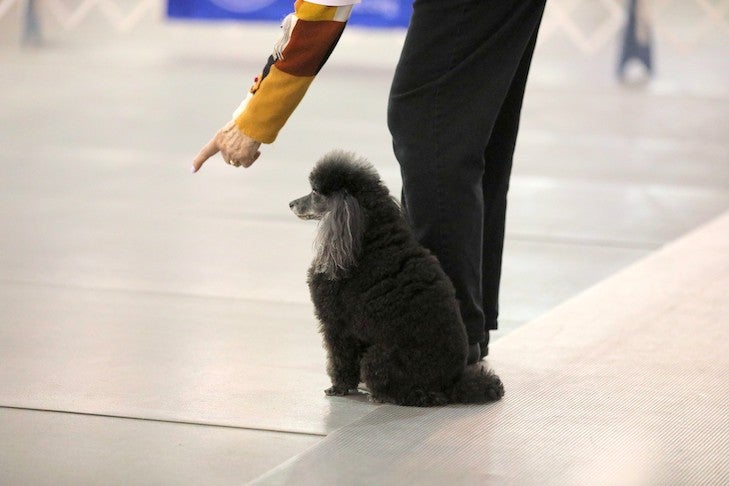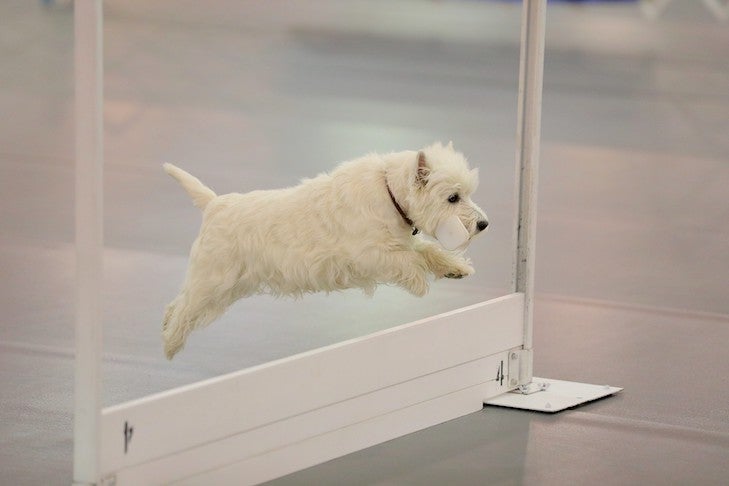
Some of the best obedience competitors in the world gather for the AKC National Obedience Championship. Just in time for this prestigious event, here’s a newcomer’s guide to the basics of watching an obedience competition — including a breakdown of classes and scoring. Even better, after learning more, you might be inspired to try one of our dog companion sports.
The Basics
Developed in the 1930s, the sport of obedience is all about fostering dogs that are well-behaved at home, in public, and in the presence of other dogs. During an obedience trial, dogs must demonstrate abilities like walking politely, staying, retrieving, and jumping, all while showing they enjoy working with their handler.
For a dog to compete in an AKC Obedience trial, he or she must be at least 6 months old and have an AKC number via AKC Registration, AKC Canine Partners, the Purebred Alternative Listing program, or the Foundation Stock Service for breeds on the road to full AKC recognition.
Intro to the Classes
There are three main levels, or classes, of competition in Obedience: Novice, Open, and Utility. Dogs start in the Novice class and advance to Open, then Utility as they master the increasingly more difficult skills. There are many optional classes to choose from that provide exercises that are half-steps between these classes. Here’s a brief rundown of the core classes:
- Novice: Dogs in this class need to demonstrate good companion skills such as coming when called, standing for an examination, staying in both a sit and down position with a group of other dogs, and heeling both on and off-leash.
- Open: Dogs in this class need to perform all of the exercises off-leash. In addition to some of the exercises performed in Novice, retrieving and jumping exercises are included.
- Utility: Dogs in this class have added challenges including directed jumping (the dog must jump over a specified hurdle) and scent discrimination (the dog must find and pick up from a pile of dumbbells, referred to as articles, the one dumbbell with the handler’s scent). Other exercises must be performed with the handler giving hand signals only.
Scoring and Titles
Each handler/dog team starts a trial with a perfect score of 200; then points are deducted for any errors. For example, if the dog is slightly out of position while heeling, that’s a deduction of points. As dogs are animals with minds of their own, and handlers are only human, obtaining a score over 195 is quite an achievement.
To receive a qualifying score, a dog needs to earn more than 50 percent of the points for each exercise and have a total score of at least 170 points. To earn titles in the sport, such as the Companion Dog Title at the Novice level, dogs need three qualifying “legs” under at least two different judges.
Benefits of Obedience
Training for obedience trials will strengthen your dog’s manners. And having a well-behaved canine family member means you can enjoy your dog’s company almost anywhere. It will also prevent many problem behaviors, like barking or jumping, by teaching your dog alternative ways to behave. Not to mention all the mental stimulation training can provide. Plus, all that teamwork in the ring will build your bond and give you both a fun activity to share. To get started in obedience, contact a local training club.
The AKC National Championship is right around the corner, and you don’t want to miss the action! Tune in to ABC on December 31 at 2 p.m. ET to see who’s crowned Best in Show.
Did you miss last year’s show? You can watch the 2022 AKC National Championship Presented by Royal Canin on demand on AKC.tv!



